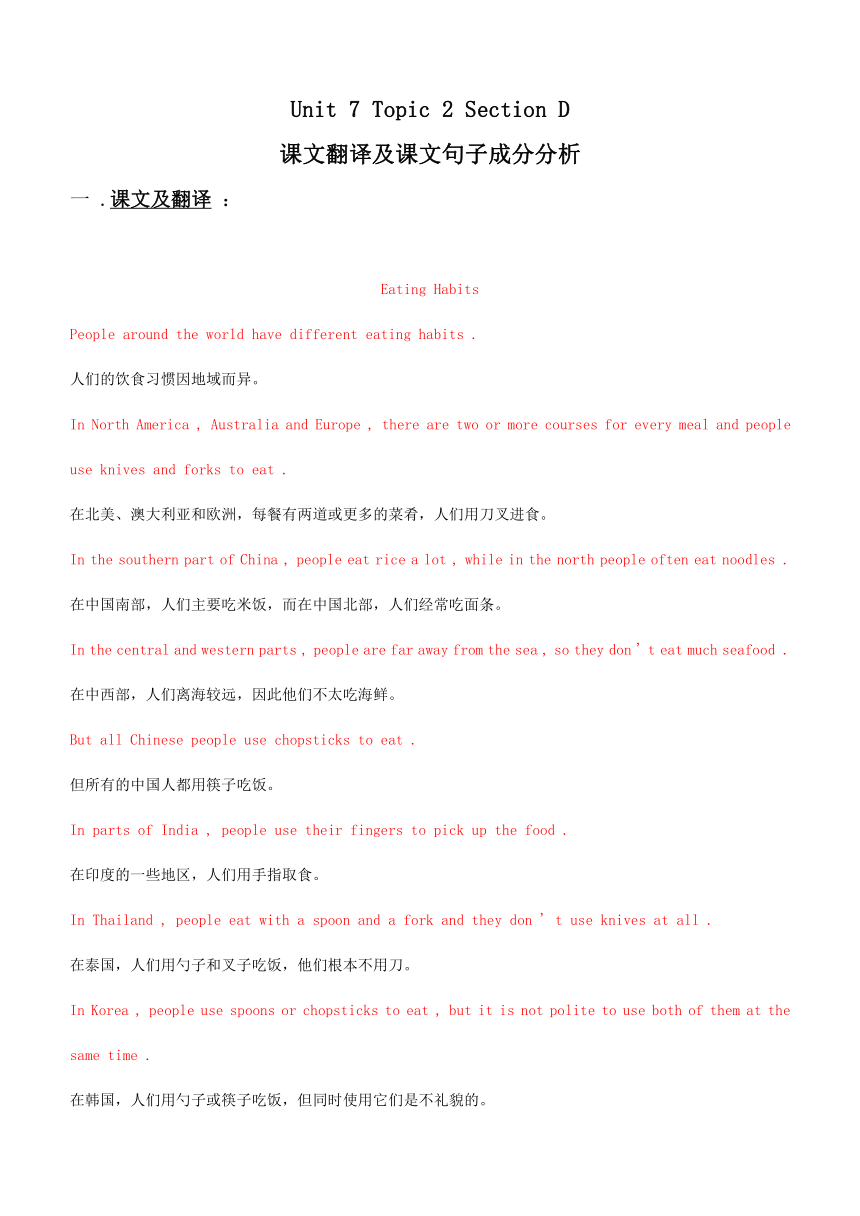
Unit 7 Topic 2 Section D 课文翻译及课文句子成分分析 一 .课文及翻译 : Eating Habits People around the world have different eating habits . 人们的饮食习惯因地域而异。 In North America , Australia and Europe , there are two or more courses for every meal and people use knives and forks to eat . 在北美、澳大利亚和欧洲,每餐有两道或更多的菜肴,人们用刀叉进食。 In the southern part of China , people eat rice a lot , while in the north people often eat noodles . 在中国南部,人们主要吃米饭,而在中国北部,人们经常吃面条。 In the central and western parts , people are far away from the sea , so they don ' t eat much seafood . 在中西部,人们离海较远,因此他们不太吃海鲜。 But all Chinese people use chopsticks to eat . 但所有的中国人都用筷子吃饭。 In parts of India , people use their fingers to pick up the food . 在印度的一些地区,人们用手指取食。 In Thailand , people eat with a spoon and a fork and they don ' t use knives at all . 在泰国,人们用勺子和叉子吃饭,他们根本不用刀。 In Korea , people use spoons or chopsticks to eat , but it is not polite to use both of them at the same time . 在韩国,人们用勺子或筷子吃饭,但同时使用它们是不礼貌的。 二 .课文句子成分分析及常见短语 : People around the world have different eating habits. 句子成分:主语(People around the world)+ 谓语(have)+ 宾语(different eating habits)。 短语及其拓展:around the world(全世界);eating habits(饮食习惯)。 In North America, Australia and Europe, there are two or more courses for every meal and people use knives and forks to eat. 句子成分: 状语(In North America, Australia and Europe) 主语(there)+ 谓语(are)+ 宾语(two or more courses) 并列句(and people use knives and forks to eat),其中主语(people)+ 谓语(use)+ 宾语(knives and forks)+ 目的状语(to eat)。 短语及其拓展:there be 结构,就近原则two or more(两个或更多);use sth to do sth。 In the southern part of China, people eat rice a lot, while in the north people often eat noodles. 句子成分: 状语(In the southern part of China)+ 主语(people)+ 谓语(eat)+ 宾语(rice)+ 状语(a lot) 并列句(while in the north people often eat noodles),其中状语(in the north)+ 主语(people)+ 谓语(eat)+ 宾语(noodles)+ 状语(often)。 短语及其拓展:a lot(很多);the southern part of China(中国南部);the north(中国北部)。 In the central and western parts, people are far away from the sea, so they don't eat much seafood. 句子成分: 状语(In the central and western parts)+ 主语(people)+ 谓语(are)+ 表语(far away from the sea) 因果句(so they don't eat much seafood),其中主语(they)+ 谓语(don't eat)+ 宾语(much seafood)。 短语及其拓展:central and western parts(中西部);far away from(远离);seafood(海鲜)。 But all Chinese people use chopsticks to eat. 句子成分:状语(But)+ 主语(all Chinese people)+ 谓语(use)+ 宾语(chopsticks)+ 目的状语(to eat)。 短语及其拓展:all Chinese people(所有中国人)。 In parts of India, people use their fingers to pick up the food. 句子成分:状语(In parts of India) ... ...
~~ 您好,已阅读到文档的结尾了 ~~

